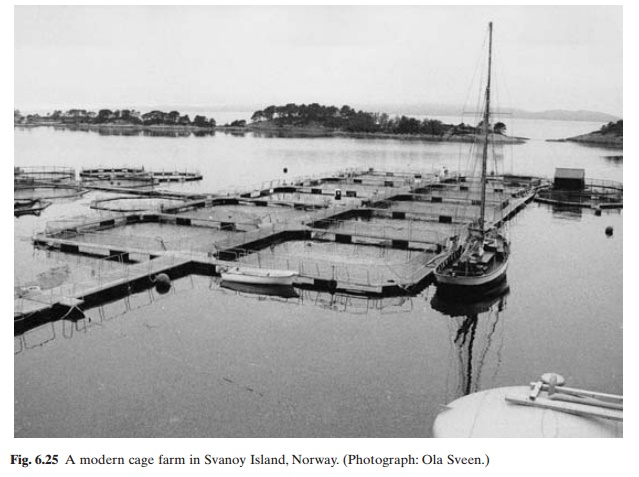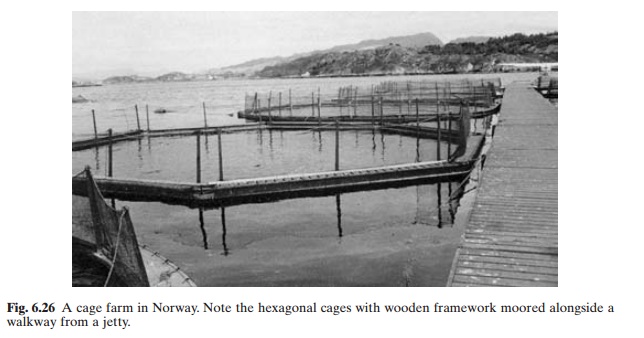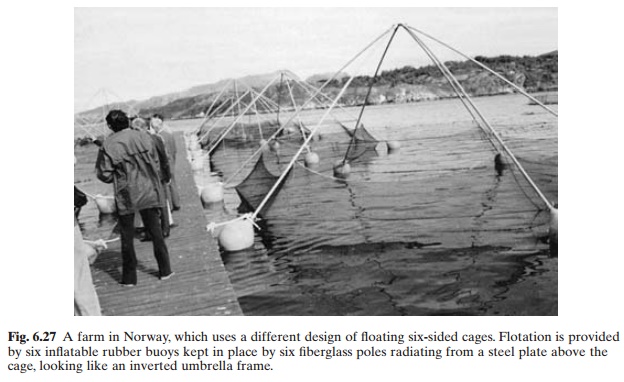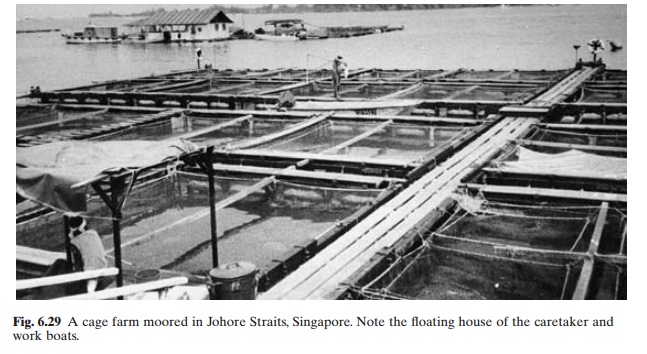Chapter: Aquaculture Principles and Practices: Design and Construction of Aquafarms
Types of cages and layout of cage farms
Types of cages and layout of cage
farms
It is obviously difficult to describe the various designs of cages
presently available. Detailed descriptions of different types of cages are
given in Beveridge (1987). Although there are submersible and rigid-walled
cages in use, the majority consist of a floating unit, a framework and a
flexible meshnet suspended under it. There are different methods of flotation
and mooring, placement and attachment of individual cages in a farm, means of
approach and handling of cages. The floating unit can consist of empty barrels,
styrofoam polyethylene pipes, or ready-made pontoons of plastic and metal. The
buoy units are often built into a framework, the material of which can be
impregnated wood, bamboo spars, galvanized scaffolding or welded aluminium
bars. Nylon is commonly used for the net, but weldmesh or even woven split
bamboo are also used. Cage flotillas provide safer working conditions and
enable storage of feed on site, as well as installation of automatic feeders.
The diversity of materials used shows that the design of the cages and cage
farms should be based on conditions prevailing at the selected site. Reasonably
sheltered areas, with sufficient water movement to effect adequate mixing and
aeration, are selected as sites for cage farms. The occurrence of typhoons,
hurricanes and cyclones in the area and the vulnerability of the site to these
are also major considerations in the design of cage farms. Polluted sites are
generally avoided. In cold climates, areas that receive safe heated water
effluents are preferred, as higher water temperatures generally improve growth
and productivity.
Unused feed and fish faeces fall from the bottom of floating net cages
on to the floor of the water body. Accumulated wastes decompose and cause
oxygen depletion or generation of methane or other toxic gases under anaerobic
conditions. Cages also increase deposition of silt on the bottom of the site.
It is therefore necessary to have enough movement of clean water below the
floating cages, and if the movement is not enough to clear them, provision has
to be made for regular mechanical removal with suction or slush pumps and
disposal of the waste at safe distances. Though the determination of precise
carrying capacity of waterbodies is difficult, at least empirical estimates
should be used to avoid overcrowding of cages.
Extensive testing of materials for construction of cages, supporting
framework, floats, sinkers, walkways, etc. has been carried out. Despite
differences in technical efficiency, different types of materials continue to
be used depending on availability and cost. The most sophisticated designs
appear to be used for sea cage farms, especially in Norway (fig. 6.25) and
Scotland. Cage size can be anything up to 1000 m3, but is normally between 100 and
500 m3. A simple unit holds a net of four vertical sides and is rectangular in
cross-section, but the more popular ones are circular in cross-section. When
timber is used as framework it is

not easy to have a perfectly circular shape and an approximation is
achieved with six- or eightsided structures. A commonly used cage in Norway has
an eight-sided floating framework of timber, which is impregnated to reduce
rotting. The sides are linked together by flexible joints to reduce the
rigidity of the structure (fig. 6.26). Planks 12 cm x 5 cm or larger form the
sides of the section and are spaced 30 cm apart by wooden slats nailed across
the top and bottom. The slats on the top should be positioned close together,
as the framework has also to serve as the walkway around the net. Expanded
polystyrene or other flotation material is inserted between the two layers of
slats and held in place by nails driven through the timber. The joint between
two sections of the frame is formed by bolting together strips of heavy
rubberized machine belts. For further safety, all the sections are securely
fastened together by suitable nylon rope or reinforcedplastic piping. In every
alternate corner of the frame a loop is provided to attach the anchoring
devices. Inside the collar, four 120 cm long laths are nailed to each of the
eight units. A nylon net is stretched between the laths to prevent leaping fish
from escaping.

Another common type of cage system used in Norway employs rectangular cages suspended from a rectangular float (as in fig. 6.25). The float consists of four PVC pontoons in iron frames. The two frames, made of 25 mm galvanized iron tubes, are connected to a wooden frame made of 5 cm x 10 cm impregnated planks with galvanized bolts and nuts. The wood frame is made in two sizes (4 m x 1 m and 5 m x 1 m), depending on the length of the two types of elements. On top, the wooden frames are covered by 2.5 cm x 12.7 cm impregnated planks. The elements of the two different lengths are joined together to form a rectangular float with a network of 4 m x 4 m square openings. The bag net, equipped with headline and leadline, is fixed to the rafts with brass hooks screwed into the wooden frame. Fence poles are erected from pedestals. The raft is usually moored by its four corners and can easily be towed.

When welded tubular metal or PVC or fibre-glass tubing is used for the
framework, there is greater flexibility in shapes and sizes of cages (fig.
6.27). Besides cost and safety of the structures, a major consideration in
designing cages is the ease with which they can be handled.
Obviously, large cages, though cheaper to buy and install, are not very
convenient in this respect and would need a larger labour force or special
mechanical equipment to handle. Cages with an underwater net volume of more
than 1000 m3 are not recommended; the preferred size is between 200 and 500 m3. It is common practice to have
double netting: the outer one serving as a predator net to protect the inner
one and the fish stock in it.
There are many ways of arranging cages in a cage farm. Where possible,
it is preferable to moor cages to a jetty with direct access to a quay, in
order to facilitate work and reduce labour costs (fig. 6.28). However,
environmental and site conditions may require them to be located farther away
from the coast, in which case a work boat will be needed for access (fig.
6.29). In either case, the cages should be installed on the sides of a central
walkway to facilitate day-to-day work on the farm. In many modern cage farms,
feed dispensers are

installed above each cage; in others, manual feeding is done. Mooring
blocks have to be sufficiently heavy and are usually made of concrete with
heavy galvanized bolts. Cages should be attached to the mooring by chain or,
for lighter structures, by nylon rope.

While the arrangement of cages in a battery is the most common practice,
in cases where infection of diseases is feared they may be moored separately.
Workers then use boats to attend to feeding and the care of the cages and fish
stock.
Most of the presently available cages are designed for use in protected
areas like bays, fjords and lakes. In order to utilize more open waters and
high seas, special cages with a flexible rubber framework have recently been
developed. Some of these designs have twin rubber booms for increased stability
in rough seas. It is claimed that the low weight of the cage reduces strain on
the moorings and contributes to all-weather capability and high durability. Other
types of very large cages made of high-strength galvanized steel, fitted with
all accessories including even independent power supply, have been tried and
are claimed to be capable of withstanding very severe storms. If such cages
prove technically and economically successful, an enormous expansion of
unpolluted potential sites for cage farming can be expected.
Related Topics